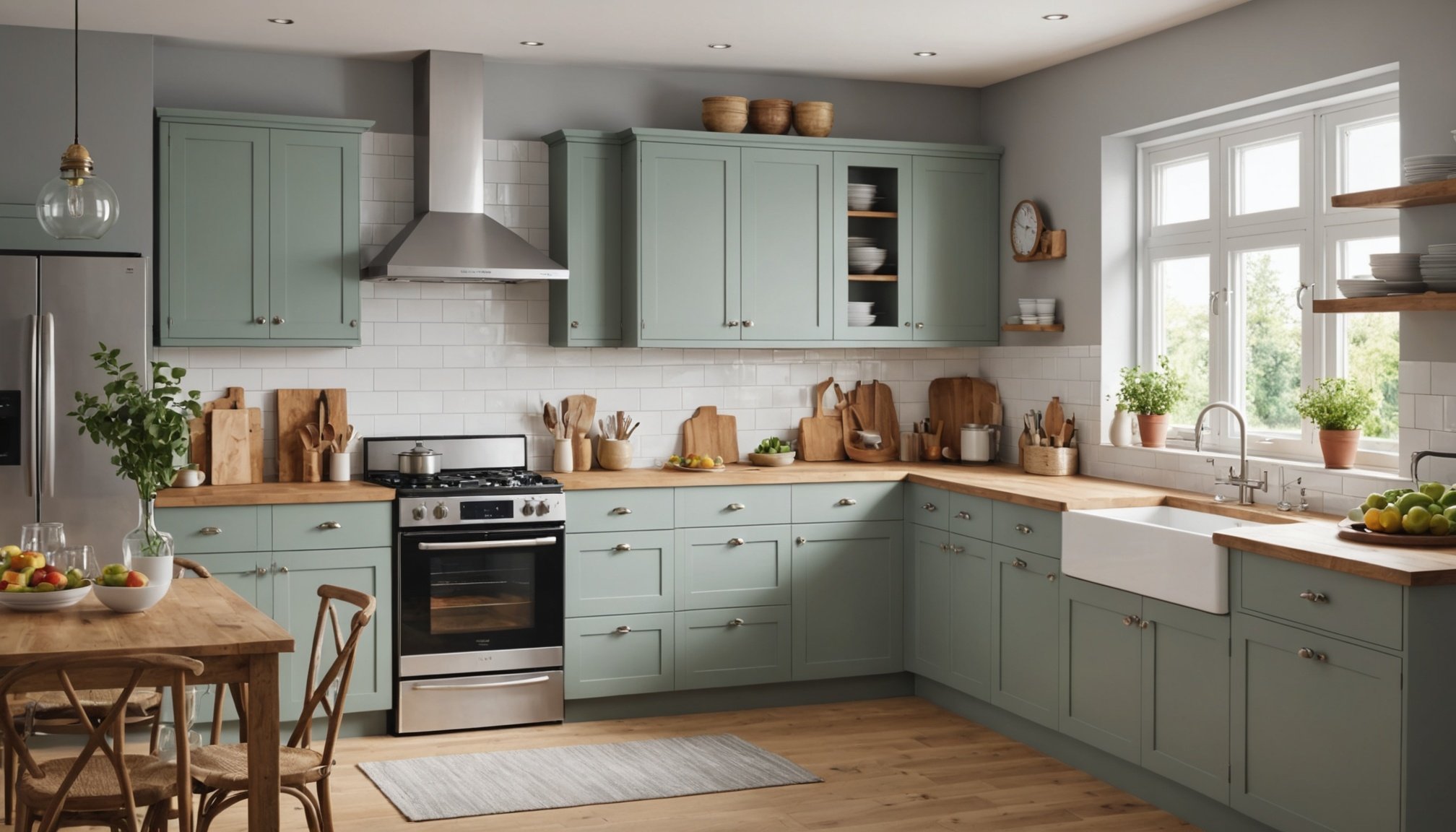A tranquil kitchen serves as a sanctuary for mental well-being, blending functionality with calming aesthetics. Thoughtful design choices can transform this space into a haven of relaxation, fostering creativity and reducing stress. By incorporating natural elements, balanced colors, and organized layout, you can create an environment that soothes the mind and elevates mood. Explore practical tips that not only enhance your kitchen's beauty but also promote a serene atmosphere, making it an integral part of your wellness journey.
Importance of a Tranquil Kitchen Environment
Creating a harmonious space for mental well-being
Also to discover : Choosing the Perfect Kitchen Island Design with an Integrated Pet Bed: A Creative Guide for Pet Lovers
Impact of Kitchen Design on Mental Health
The design of a kitchen significantly influences one's mental well-being. A cluttered or chaotic environment can lead to increased stress and anxiety. In contrast, a well-organized and aesthetically pleasing kitchen promotes calmness and relaxation. Implementing thoughtful design elements like natural lighting, soothing color schemes, and ergonomic layouts can transform the kitchen into a sanctuary for the mind.
Psychological Benefits of a Calming Kitchen Space
A calming kitchen space can offer numerous psychological benefits. It serves as a retreat from daily stressors, encouraging mindfulness and presence. The act of cooking in a serene environment can be meditative, fostering a sense of accomplishment and satisfaction.
Also read : Designing a Multi-Sensory Kitchen Experience for Individuals with Visual Impairments
Role of Sensory Experiences in Promoting Relaxation
Sensory experiences play a crucial role in a tranquil kitchen. The gentle hum of a robot hoover, the aroma of fresh herbs, and the sight of clean surfaces all contribute to a soothing atmosphere. These elements help to engage the senses positively, enhancing overall mental well-being.
- Natural Lighting: Boosts mood and energy levels
- Soundscapes: Soft music or nature sounds
- Aromatherapy: Use of essential oils for calming effects
Creating a kitchen that prioritizes these aspects can lead to a more balanced and peaceful lifestyle.
Color Palettes for a Calming Atmosphere
Exploring the influence of colors on tranquility
Soft Neutrals and Earthy Tones
The use of soft neutrals and earthy tones in kitchen design can significantly enhance a tranquil atmosphere. These colors, such as beige, taupe, and muted greens, are known for their ability to create a soothing environment. They help in reducing visual clutter and promoting a sense of calm. Incorporating these hues into your kitchen can foster a peaceful and inviting space.
- Beige: Offers warmth and comfort
- Taupe: Provides a neutral backdrop
- Muted Greens: Connects with nature
Accent Colors that Promote Calm
Incorporating accent colors that promote calm can transform a kitchen into a sanctuary. Color psychology suggests that shades like soft blues and gentle lavenders can evoke relaxation and tranquility. These colors can be integrated through elements such as backsplash tiles or kitchen accessories, adding a subtle yet impactful touch.
The Impact of Color on Mood
The impact of color on mood is profound, influencing emotions and mental states. A carefully chosen color palette can enhance mental well-being by creating a harmonious environment. By understanding color psychology, one can select kitchen colors that not only beautify the space but also promote a tranquil design.
Functional Layouts that Enhance Relaxation
Optimizing kitchen spaces for stress-free environments
Principles of an Efficient Kitchen Layout
A functional design is pivotal in crafting a kitchen that minimizes stress. Key principles include the work triangle, which efficiently connects the stove, sink, and refrigerator. This layout reduces unnecessary movement, streamlining tasks and promoting relaxation. Incorporating clear zones for cooking, eating, and relaxing helps maintain organization, further enhancing the kitchen's functionality.
Zones for Cooking, Eating, and Relaxing
Designating specific zones within the kitchen can significantly reduce stress. A well-planned cooking zone ensures all necessary tools and ingredients are within easy reach. An inviting eating area encourages relaxation and social interaction. Finally, a dedicated space for relaxing, perhaps with a cozy chair or plants, allows for unwinding after a busy day.
Designing Pathways that Reduce Chaos and Enhance Flow
Strategically designed pathways are crucial in a kitchen layout that aims to reduce chaos. Ensuring smooth traffic flow prevents bottlenecks and accidents, creating a more harmonious environment. Consider these elements:
- Work Triangle: Efficient task management
- Clear Zones: Organized and stress-free
- Smooth Pathways: Enhanced movement and flow
By adhering to these principles, a kitchen can become a sanctuary of calm and productivity.
Material Choices that Foster Tranquility
Crafting a serene kitchen with thoughtful materials
Incorporating Natural Materials
Using natural materials in kitchen design can significantly enhance tranquility. Materials like wood, stone, and bamboo introduce a warm and organic feel to the space. These elements not only add aesthetic appeal but also connect the kitchen to nature, promoting a sense of calm and balance. Consider using wooden countertops or stone backsplashes to integrate these materials seamlessly.
The Benefits of Textured Surfaces
Textured surfaces in the kitchen, such as rough stone or grainy wood, provide tactile stimulation that can be soothing. These surfaces add depth and interest, breaking the monotony of smooth finishes. They also help in reducing visual clutter by absorbing light and softening harsh reflections.
- Stone: Adds a natural, grounding element
- Wood: Offers warmth and organic beauty
- Bamboo: Sustainable and versatile
Choosing Sustainable Options for Peace of Mind
Opting for sustainable design choices not only benefits the environment but also enhances personal well-being. Materials like recycled glass or reclaimed wood are eco-friendly and promote peace of mind. By selecting sustainable options, you contribute to a healthier planet and a more tranquil kitchen environment.
Decor Ideas that Create a Soothing Ambiance
Crafting a serene kitchen environment with thoughtful decor
Selecting Decor that Complements the Calming Theme
Choosing the right kitchen decor is essential in establishing a relaxing atmosphere. Opt for accessories that harmonize with the existing color palette and materials. Incorporate tranquil accessories like soft-textured rugs or simple ceramic vases. These elements can subtly enhance the calming theme without overwhelming the space.
The Role of Plants and Greenery in the Kitchen
Integrating plants and greenery into your kitchen can significantly boost its tranquility. Plants not only purify the air but also add a touch of nature, fostering a relaxing atmosphere. Consider low-maintenance options like succulents or herbs that thrive indoors. These tranquil accessories can be strategically placed on windowsills or countertops to create a lively yet soothing environment.
Lighting Options that Promote Relaxation
Lighting plays a pivotal role in shaping a relaxing atmosphere. Soft, ambient lighting can transform the kitchen into a welcoming retreat. Consider installing dimmable lights or using LED bulbs with warm tones. Kitchen decor such as elegant pendant lights or under-cabinet lighting can enhance the ambiance, ensuring the space remains both functional and serene.
- Soft Textured Rugs: Comfort and warmth
- Ceramic Vases: Simple elegance
- Dimmable Lights: Adjustable mood setting
Expert Insights and Psychological Concepts
Understanding the intersection of design and psychology
Interviews with Interior Designers
Interior designers emphasize the psychological impact of a well-planned kitchen. According to expert advice, incorporating design insights such as balanced color schemes and strategic lighting can significantly enhance mood. A designer noted, "A harmonious space isn't just about aesthetics; it's about creating an environment that supports mental well-being." Their insights reveal how even minor adjustments can lead to profound changes in emotional health.
Research on Space and Mood
Recent studies highlight the psychological impact of spatial design on mood. Research indicates that design insights such as open layouts and natural materials contribute to a sense of calm and relaxation. A study found that 75% of participants reported improved mood in well-designed spaces. This underscores the importance of expert advice in crafting environments that nurture the mind.
Practical Tips from Psychological Studies
Psychological studies provide practical tips for enhancing kitchen spaces. Implementing design insights like decluttering and using calming colors can significantly reduce stress. Expert advice also suggests incorporating elements like plants and textured surfaces to foster tranquility.
- Declutter: Minimizes stress
- Calming Colors: Enhances mood
- Plants: Boosts relaxation
These strategies underscore the psychological impact of thoughtful design.













